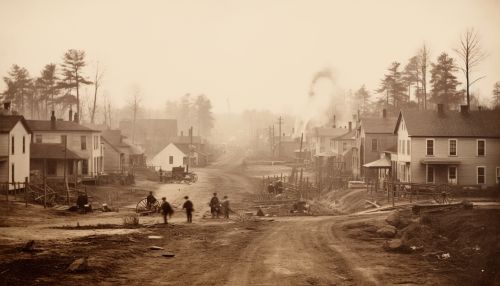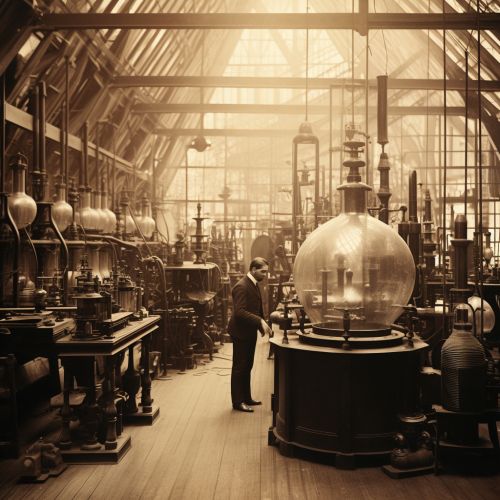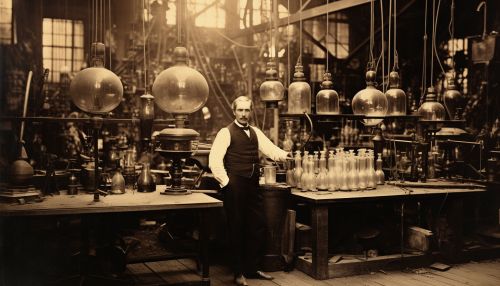Thomas Edison
Early Life
Thomas Alva Edison was born on February 11, 1847, in Milan, Ohio. He was the seventh and last child of Samuel Ogden Edison Jr. (1804–1896, born in Marshalltown, Nova Scotia) and Nancy Matthews Elliott (1810–1871, born in Chenango County, New York). His father had to escape from Canada because he took part in the unsuccessful Mackenzie Rebellion of 1837. His father, Samuel Sr., had earlier fought in the War of 1812 as captain of the First Middlesex Regiment. By contrast, Samuel Jr.'s struggle found him on the losing side, and he crossed into the United States at Sarnia-Port Huron. Once across the border, he found his way to Milan, Ohio. His patrilineal family line was Dutch by way of New Jersey; the surname had originally been "Edeson."


Education
Edison's family moved to Port Huron, Michigan, after the railroad bypassed Milan in 1854 and business declined. Edison sold candy and newspapers on trains running from Port Huron to Detroit, and he sold vegetables to supplement his income. This began Edison's long streak of entrepreneurial ventures as he discovered his talents as a businessman. These talents eventually led him to found 14 companies, including General Electric, which is still one of the largest publicly traded companies in the world.
Inventions and Innovations
Edison is credited with developing many devices in fields such as electric power generation, mass communication, sound recording, and motion pictures. These inventions, which include the phonograph, the motion picture camera, and early versions of the electric light bulb, have had a widespread impact on the modern industrialized world. He is often credited with establishing the first industrial research laboratory, known as the Menlo Park Research Laboratory, where he employed many researchers and staff to assist him with his inventions.
Phonograph
Edison's first great invention was the phonograph in 1877. Despite his lack of a formal scientific education, Edison was one of the first inventors to apply the principles of mass production and teamwork to the process of invention, and because of that, he is often credited with the creation of the first industrial research laboratory.
Electric Light
Edison is perhaps best known for his development of the practical electric light bulb. Contrary to popular belief, Edison did not invent the light bulb, but instead improved upon a 50-year-old idea. In 1879, using lower current electricity, a small carbonized filament, and an improved vacuum inside the globe, he was able to produce a reliable, long-lasting source of light. The idea of electric lighting was not new, and a number of people had worked on, and even developed forms of electric lighting. But up to that time, nothing had been developed that was remotely practical for home use. Edison's eventual achievement was inventing not just an incandescent electric light, but also an electric lighting system that contained all the elements necessary to make the incandescent light practical, safe, and economical. After one and a half years of work, success was achieved when an incandescent lamp with a filament of carbonized sewing thread burned for thirteen and a half hours.


Motion Picture Camera
Edison's interest in motion pictures began before 1888, however, the visit of Eadweard Muybridge to the inventor's laboratory in West Orange in February of that year certainly stimulated Edison's resolve to invent a motion picture camera. Edison's experiments with motion pictures were an extension of his interest in sound recording, involving a similar concept: the recording and reproduction of physical impressions. In the case of the phonograph, the impressions were sound waves; with motion pictures, they were composed of light and dark images in a sequence to represent continuous motion.
Later Life and Death
In his later years, Edison became involved in several mining operations, one of which was the Ogden Iron Company in Ogdensburg, New Jersey, which Edison had hoped to make a success by selling the iron ore to the Pennsylvania Railroad for use in its extensive network of rail lines. However, the venture proved to be unprofitable and was eventually abandoned.
Edison died of complications of diabetes on October 18, 1931, in his home, "Glenmont" in Llewellyn Park in West Orange, New Jersey, which he had purchased in 1886 as a wedding gift for his second wife, Mina Miller Edison. He is buried behind the home.
Legacy
Edison's inventions and innovations are a testament to his genius and hard work. His impact on modern society is profound, having laid the groundwork for many of the technologies we take for granted today. His work in developing the phonograph, the motion picture camera, and the practical electric light bulb revolutionized entertainment, communication, and illuminated the world in a way that had never been done before.


